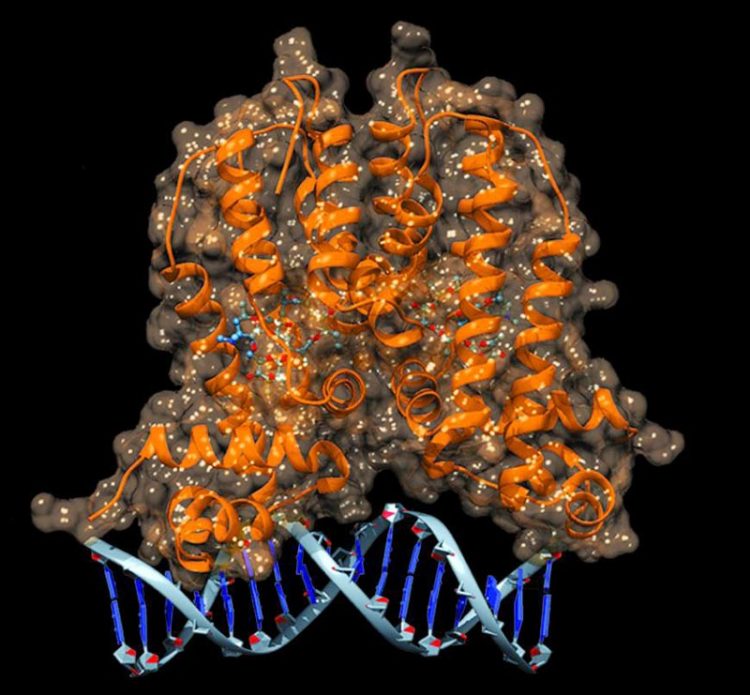Designer biosensor can detect antibiotic production by microbes

This is MphR biosensor binding to its target DNA sequence. Credit: Edward Kalkreuter
Macrolides are a group of naturally occurring small molecules that can have antibiotic, antifungal or anticancer effects. The antibiotic erythromycin is one example – it is a macrolide produced by soil-dwelling bacteria.
Researchers are interested in using these natural antibiotics and the microbes that produce them in order to develop new antibiotics; however, microbes that produce antibiotic macrolides only make small amounts of a limited variety of antibiotics.
“Our ultimate goal is to engineer microbes to make new versions of these antibiotics for our use, which will drastically reduce the amount of time and money necessary for new drug testing and development,” says Gavin Williams, associate professor of bio-organic chemistry at NC State and corresponding author of a paper describing the research.
“In order to do that, we first need to be able to detect the antibiotic molecules of interest produced by the microbes.”
Williams and his team used a naturally occurring molecular switch – a protein called MphR – as their biosensor. In E. coli, MphR can detect the presence of macrolide antibiotics being secreted by microbes that are attacking E. coli. When MphR senses the antibiotic, it turns on a resistance mechanism to negate the antibiotic's effects.
The researchers created a large library of MphR protein variants and screened them for the ability to switch on production of a fluorescent green protein when they were in the presence of a desired macrolide. They tested the variants against erythromycin, which MphR already recognizes, and found that some of the MphR variants improved their detection ability tenfold. They also successfully tested the variants against macrolides that were not closely related to erythromycin, such as tylosin.
“Essentially we have co-opted and evolved the MphR sensor system, increasing its sensitivity in recognizing the molecules that we're interested in,” says Williams.
“We know that we can tailor this biosensor and that it will detect the molecules we're interested in, which will enable us to screen millions of different strains quickly. This is the first step toward high-throughput engineering of antibiotics, where we create vast libraries of genetically modified strains and variants of microbes in order to find the few strains and variants that produce the desired molecule in the desired yield.”
The research appears in ACS Synthetic Biology, and was funded by the National Institutes of Health (grant GM104258) and the NC State Chancellor's Innovation Fund. Graduate student Yiwei Li, former graduate student Christian Kasey, former undergraduate student Mounir Zerrad, and T. Ashton Cropp, professor of chemistry at Virginia Commonwealth University, contributed to the work.
###
Note to editors: An abstract of the paper follows.
“Development of transcription factor-based designer macrolide biosensors for metabolic engineering and synthetic biology”
Authors: Christian Kasey, Mounir Zerrad, Yiwei Li, Gavin Williams, North Carolina State University; Ashton Cropp, Virginia Commonwealth University
Published: ACS Synthetic Biology
DOI: 10.1021/acssynbio.7b00287
Abstract:
Macrolides are a large group of natural products that display broad and potent biological activities and are biosynthesized by type I polyketide synthases (PKSs) and associated enzymatic machinery. There is an urgent need to access macrolides and unnatural macrolide derivatives for drug discovery, drug manufacture, and probe development. Typically, efforts to engineer the biosynthesis of macrolides and macrolide analogues in various microbial hosts are hampered by the complexity of macrolide biosynthetic pathways and our limited ability to rationally reprogram type I PKSs and post-PKS machinery. High-throughput approaches based on synthetic biology and directed evolution could overcome this problem by testing the function of large libraries of variants. Yet, methods that can identify mutant enzymes, pathways, and strains that produce the desired macrolide target are not generally available. Here we show that the promiscuous macrolide sensing transcription factor MphR is a powerful platform for engineering variants with tailored properties. We identified variants that displayed improved sensitivity towards erythromycin, tailored the inducer specificity, and significantly improved sensitivity to macrolides that were very poor inducers of the wild-type MphR biosensor. Designer macrolide biosensors should find broad utility and enable applications related to high throughput synthetic biology and directed evolution of macrolide biosynthesis.
Media Contact
All latest news from the category: Life Sciences and Chemistry
Articles and reports from the Life Sciences and chemistry area deal with applied and basic research into modern biology, chemistry and human medicine.
Valuable information can be found on a range of life sciences fields including bacteriology, biochemistry, bionics, bioinformatics, biophysics, biotechnology, genetics, geobotany, human biology, marine biology, microbiology, molecular biology, cellular biology, zoology, bioinorganic chemistry, microchemistry and environmental chemistry.
Newest articles

First-of-its-kind study uses remote sensing to monitor plastic debris in rivers and lakes
Remote sensing creates a cost-effective solution to monitoring plastic pollution. A first-of-its-kind study from researchers at the University of Minnesota Twin Cities shows how remote sensing can help monitor and…

Laser-based artificial neuron mimics nerve cell functions at lightning speed
With a processing speed a billion times faster than nature, chip-based laser neuron could help advance AI tasks such as pattern recognition and sequence prediction. Researchers have developed a laser-based…

Optimising the processing of plastic waste
Just one look in the yellow bin reveals a colourful jumble of different types of plastic. However, the purer and more uniform plastic waste is, the easier it is to…



